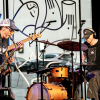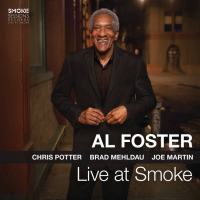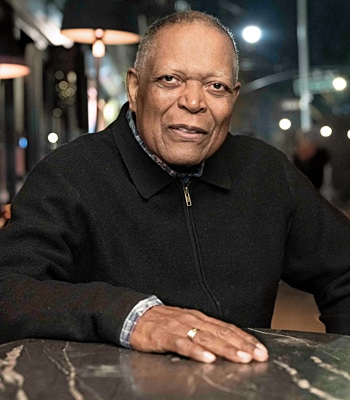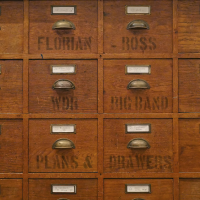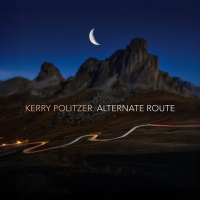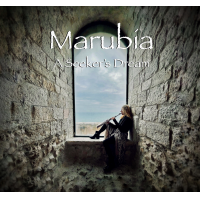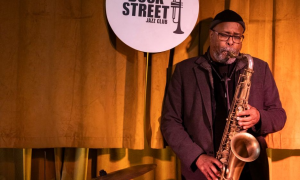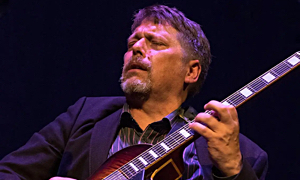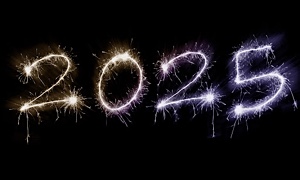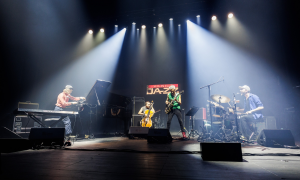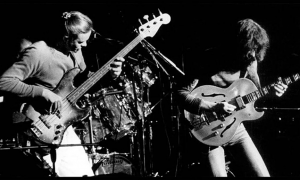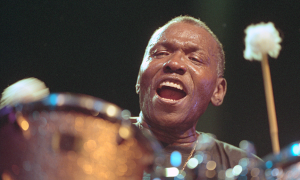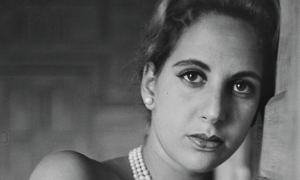Home » Jazz Articles » Live Review » Viljandi Folk Music Festival 2025
Viljandi Folk Music Festival 2025

Courtesy Kaspars Zaviļeiskis
Viljandi Castle Hills
Viljandi, Estonia
July 24-27 2025
When your scribe first visited the Viljandi Folk Music Festival in 2021, it was still straggling along within the lockdown period, held with a reduced crowd capacity. The long weekend seemed perfectly well-attended, even under those circumstances, given its sprawling, multi-hilled setting. Fears of the full enchilada of an uninhibited 2025 festival (the 32nd edition) were unfounded, as although it was massing with more folkers, this was not exacerbated to an unpleasant degree. The vibration remained of a homely gathering for hardcore traditionalists, with an emphasis on indigenous Estonian acts, augmented by a strong contingent of international performers. Admittedly, we were not talking WOMAD, Oslo World or even Ethno-Port in terms of already-renowned acts, but the music still raised high in quality, introducing the attendee to unfamiliar greatnesses.
The Castle Hills have four main outdoor stages, and three indoors, the latter having a much smaller capacity, and the application of strict concert hall rules (i.e. silence, punctuality, no admission after the curtains part).
A significant musical highlight came from Norway, early on the Saturday, as the Sámi singer and guitarist Torgeir Vassvik played on the Kaevumägi stage, effectively inhabiting the ruins of a hilltop castle. Vassvik was joined by the Finnish prepared-electric guitarist Juhani Silvola, who now dwells in Norway. This duo formation allowed the co- existence of hardcore acoustic string-tension and heavily dispersed amplifier emissions, sometimes soundscaping, but at others demonstrating a corrosive prickle-burn attack. The combination melded free improvisation, joik-singing traditionalism, avant singer-songwriter and ambient imaginary film-scoring. Diverse aspects were filtered through these two powerful musical personalities. Vassvik describes his songs as joik noir. To the outsider, Vassvik's vocals sounded like unwatered Sámi stylings, guttural, ululating and precisely shaped. His guitar lines had a metallic ring to the strings, as Silvola shaded with effects mists, using a bottleneck, then delivering a gnarled solo, as Vassvik's growling voice returned. Silvola used a bow to create floating textures, and when Vassvik riffed percussively, his strings held an edge of distortion.
Completely impressed, your scribe caught them again on Sunday, once again opening up the afternoon in a fashion which pervaded the next few hours with its masterful atmospheric effect. This time the pair appeared on the Kirsimägi stage (number 1), another outdoor grove, this time flanked by trees, and boasting grassy ground. This second set may well have lacked the closely-gathered intensity and mood of the first set, but it entered a completely different world of dancing, the audience having more space to display their impressively idiosyncratic moves. It was like an avant-hippy summit!
One number had a toughened rockabilly riff, with Silvola adding what sounded like ultra-distorted Zimbabwean licks, all angular stress and darkening strums. Vassvik's acoustic axe got heavier, chopping through the arboreal rows, as we rode an ambling bear into the hinterland, clutching tufts of fur in flight (and fright). Indeed, a bear was the subject of the next song, the sun carrier beast always having its penis root-bone stolen from its sacred skeleton, for spiritual usage. Vassvik sang in joik-fashion, as the bear's soul was carried to the other side. His tone was reminiscent of a Tuvan mouth-cavity vibration, the out-front dancers prompted into a ritualistic sway. Meanwhile, a wind-whip announced an oncoming storm, to close this mostly sweltering weekend.
A more predictable highlight was provided on the Friday, on the other Kirsimägi stage (number 2) by the Ukrainian folk-rock band Svjata Vatra, whose leader Ruslan Trochynskyi (vocals/trombone) has long been resident in Estonia. Predictable not through their songs, but due to their familiarity on the Estonian festival circuit. They are empowered by their 20th anniversary celebrations. Trochynskyi flopped folk onto post-punk roistering, just the right side of anthemic, flanked by his daughter Rute, who herself is set to be a star, if she's not already. Their song-banter lifted each number, interspersed by the leader's funksome 'bone solos, blaring lowness with gusto and accuracy. The lines were delivered in Estonian and Ukrainian. Guitar solos reinforced the crusading strength, then Estonian bagpipes cut through courtesy of Juhan Suits. This band never disappoints.
Almost certainly the best old school Estonian folk band on show was the Kirbla Trio, with their distinctive line-up of jaw harp (Katariin Raska), kannel (Leanne Barbo) and diatonic accordion (Natali Ponetajev). They made multiple duo variations, as well as playing as a threesome, such as twinning the jaw harp, or pairing kannel with accordion, the latter showing how it's the dance master, when it entered. The grassy circulations involved an odd couple-forward, then circling, with a foot-shuffle movement, in an inward jostle, an introverted palpitation, of course being much more organised than the Vassvik dancers. They also skip-tripped, with handclaps. The zither-like kannel almost provided a tingling prog rock strum-sound. There was another jaw harp duet (a rare thrill!), complete with hand-wafts, like a blues harp-blower, as a drone oscillation amassed, basslines emerging out of the ether.
Toomas Valk plays the garmon button accordion, a breed of the instrument that even several musicians questioned by your scribe hadn't heard of, but which (judging by this weekend) has become an extremely popular choice, and perhaps the latest folk fad. Valk also stomped his foot, leading a lyrical sway, while adding decorative trills. He played dual parts, both low and high, resulting in a big sound, once channeled out through the p.a. Time signatures could change within a tune, an acceleration made as Valk pumped quite furiously. He also sang the odd jaunty vocal. Towards the finish, he stood up to play, becoming even more animated.
From the Isle Of Man, Elisabeth Davidson-Blyth (fiddle) and Daniel Quayle (acoustic guitar) produced what could be termed 'enhanced folk,' with electro-bass and beats providing a bedrock, at very high comparative volume, but nevertheless capturing the traditional Manxian song-spirit in its construction.
Cätlin and Marko Mägi (Estonian bagpipes, jaw harp, tenor saxophone) invited Finlay MacDonald (Scottish bagpipes) and Ali Hutton (guitar) to form an Estonian-Scottish alliance, the latter pair jumping onstage after the natives had opened with a run of their own pieces.
There were also performances in the contrastingly studious Traditional Music Centre, involving a greater degree of introductory narratives, meaning that non-Estonians missed out on the background, but could still bask in the foreground of the inspired music. The Estlager Trio presented In Search Of Village Musicians, featuring players discovered during an exploratory tour of Estonia. This became a strong whirl around a circle of artists, the only drawback being that the Estlagers didn't get to play too many tunes themselves.
Then, the violinist Regina Mänd presented A Tribute To Pärnumaa Fiddlers, amalgamating film, narrative and solo playing to evoke the village folk repertoire of this Estonian county. Once again, a command of the Estonian language would have been useful, but the tunes and the atmosphere made the experience valuable.
From beyond Estonia came several ensembles from further-flung lands. Laposa Julcsi And The Band brought an overload of variety, in terms of material and formations within the line-up, sliding from their native Hungary towards Slovenia, Bulgaria and Serbia, or at least sounding similar to those folk sources. A solo hurdy-gurdy stood out, then a slice of the band surfaced, with just vocals, bass and a pair of fiddles. Their mission involved unfiltered folk, and this crew sounded way better than they do on their recent album. A sweeping climax pulled forward a massive circle of dancers who eventually trotted too close to a line-dancing formation.
The Natig Rhythm Group concentrated on percussion power, constructing complex passages of dense interaction, skins possessing an almost metallic ringing force. Natig Shirinov and his family band hail from Azerbaijan, and have the gift of sustaining dynamic groove patterns over marathon distances, only calming down for a few interludes with a more mainstream backing track.
Tuareg guitarist Kader Tarhanine explored the mellower aspects of Saharan song, focusing on slow ballads, with twinned guitars, bass, djembe and drumkit. Gliding with the promise of acceleration, Tarhanine produced more of a guitar-chime for the second song, with emphatic bass, and vocals calling higher. For the third number, another notch was jumped, prompting the crowd to dance after only 15 minutes.
Tags
PREVIOUS / NEXT
Support All About Jazz
 All About Jazz has been a pillar of jazz since 1995, championing it as an art form and, more importantly, supporting the musicians who make it. Our enduring commitment has made "AAJ" one of the most culturally important websites of its kind, read by hundreds of thousands of fans, musicians and industry figures every month.
All About Jazz has been a pillar of jazz since 1995, championing it as an art form and, more importantly, supporting the musicians who make it. Our enduring commitment has made "AAJ" one of the most culturally important websites of its kind, read by hundreds of thousands of fans, musicians and industry figures every month.


